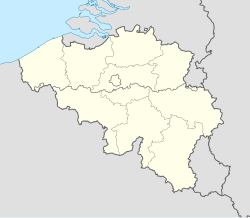Top Qs
Timeline
Chat
Perspective
Hermalle-sous-Huy train collision
2016 rail crash in Belgium From Wikipedia, the free encyclopedia
Remove ads
The Hermalle-sous-Huy train collision was a collision between a passenger train and a freight train in Hermalle-sous-Huy, Belgium, on 5 June 2016. At least three people were killed and 36 others were injured, nine of them seriously.
Remove ads
The crash
Summarize
Perspective
The crash occurred at 23:03 CEST (21:03 UTC),[1] when the passenger train crashed into the rear of the goods train while the two trains were on the same line.[2] The driver of the passenger train was one of the fatalities.[3] All on board had been rescued from the train by 02:00 on 6 June.[4] Those less seriously injured were taken to Flône Abbey,[1] or a nearby sports centre.[4] The passenger train comprised two SNCB Class AM96 electric multiple units.[1] It was travelling from Mouscron to Liers via Namur and Liège. The freight train had about 30 wagons in its consist.[5]
The front two carriages of unit 548 were severely damaged.[3][6] Unit 461 was at the rear of the train.[4] It had about 40 passengers on board. The passenger train was travelling at about 90 kilometres per hour (56 mph) when it ran into the rear of the freight train,[7] which was either stationary,[5] or travelling at 10 to 15 kilometres per hour (6 to 9 mph).[3] It was reported that an earlier lightning strike had caused disruption on the Liège–Namur railway line.[8] A signal fault had been reported at 21:30, but was said to have been cleared at the time of the accident.[7] Belgian Prime Minister Charles Michel tweeted his condolences to the victims and wished the injured a speedy recovery.[9] He and King Philippe visited the site of the accident on 6 June.[3]
Following the accident, it was revealed that the signal that was passed at danger was not equipped with the TBL 1+ train protection system, which is capable of automatic brake application if a train passes a red signal. This system was introduced following the Buizingen train crash in 2010.[10]
The train event recorders of the passenger train were recovered from the wreckage on 8 June in an apparently undamaged condition.[11] Infrabel stated that repairs to the tracks to allow single-line working for intercity trains would be completed by 8 June, with local trains being replaced by buses. It was intended that all track repairs would be completed by the evening of 9 June,[12] which was achieved. Normal service resumed that day. Damage to the track required the replacement of 15 metres (16 yd) of rail and 50 metres (55 yd) of sleepers.[13]
Remove ads
Investigation
The Railway Accident and Incident Investigation Unit of the Federal Public Service Mobility and Transport opened an investigation into the accident.[14]
The train event recorder revealed that the driver of the train passed a signal displaying a double yellow (caution) aspect.[a] However, he only started to brake when the freight train came in sight.[13] The investigation resulted in an intermediate report being published in June 2017. It concluded that it was likely that the passenger train overran a red signal.[6]
Remove ads
Notes
- A double yellow signal means that the signal ahead is showing a red (danger) aspect. See Belgian railway signalling for further details.
References
Wikiwand - on
Seamless Wikipedia browsing. On steroids.
Remove ads


